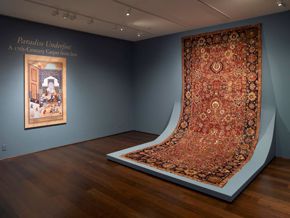Paradise Underfoot: A 17th-Century Carpet from Iran December 12, 2011–June 10, 2012

Paradise Underfoot: A 17th-Century Carpet from Iran showcases a rug from the Bayou Bend Collection, accompanied by a painting from the Metropolitan Museum of Art.
Iran, Rug (detail), 17th century, wool, the MFAH, the Bayou Bend Collection, gift of Miss Ima Hogg.
Herat (present-day Afghanistan), Layla and Majnum in School, folio from a Khamsa (Quintet) of Nizami, c. 1472–1536, calligraphers: Sultan Muhammad Nur, Mahmud Muzahib; artists: Sultan Muhammad, Shaykh Zada; author: Nizami (Ilyas Abu Muhammad Nizam al-Din of Ganja), ink, colors, and gold on paper, Metropolitan Museum of Art, gift of Alexander Smith Cochran, 1913.
In anticipation of the opening of the Arts of the Islamic World Gallery at the MFAH in January 2013, Paradise Underfoot: A 17th-Century Carpet from Iran presents one of the earliest works of Islamic art to enter the museum's collection.
This magnificent carpet exemplifies the “golden age” of Persian carpet weaving—rugs created in the 16th and 17th centuries, renowned for their beauty and durability. Fabricated in the 1800s in what is now Iran, this wool carpet was acquired by the Bayou Bend Collection in 1960.
Carpets in the Islamic world defined different spaces in the lives of their owners, such as a sacred space for prayer or an imagined space for brilliant ornamentation in a simple, nomadic dwelling. Another role was as a reverent space for the privileged or wealthy to sit, as demonstrated in the accompanying painting Layla and Majnum in School.
The design woven into this carpet reflects the vision of gardens that figures prominently in the Islamic faith and Muslim arts and culture. Gardens held great social significance, because they were seen as a luxury, as well as spiritual importance because of their allusions to a celestial paradise. The intricately woven palmettes, vine tracery, and abundance of other floral motifs covering this example allowed its owner to create a portable, paradisiacal garden on earth.
This exhibition is organized by the Museum of Fine Arts, Houston.
